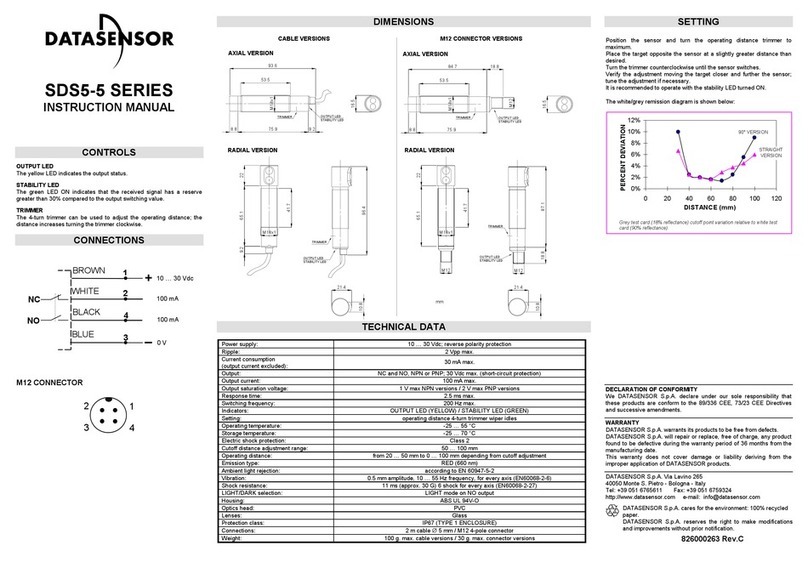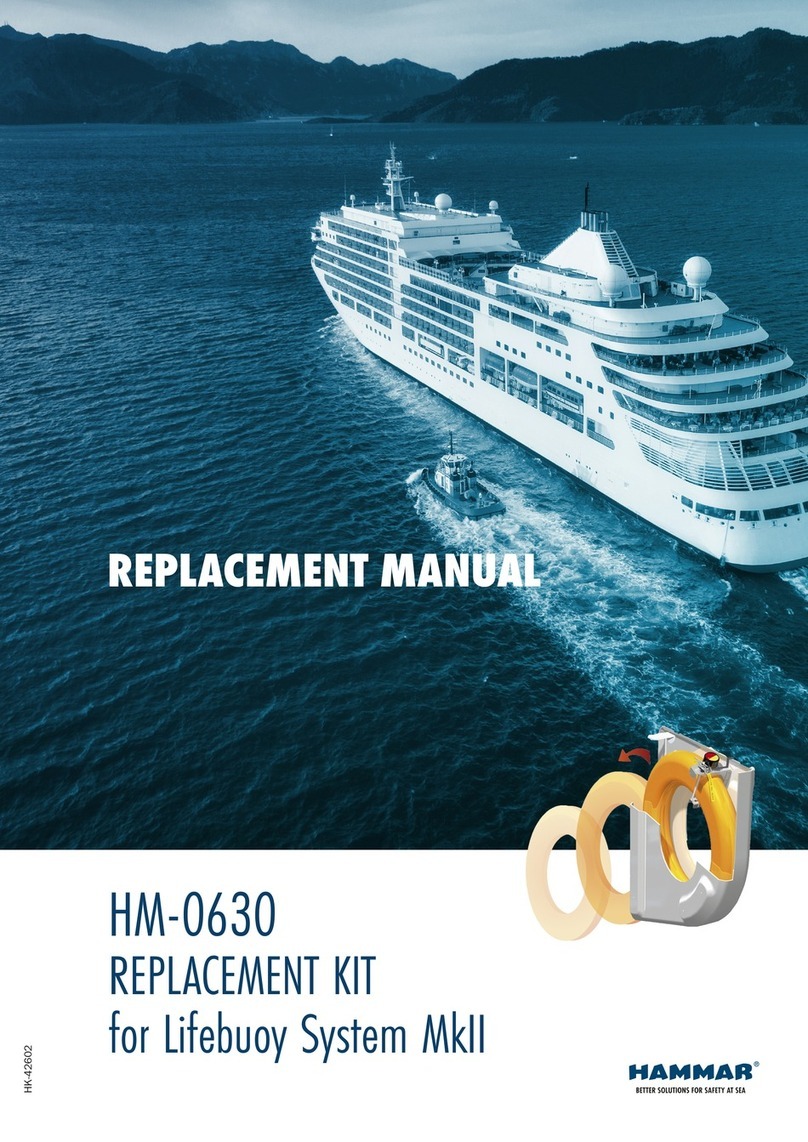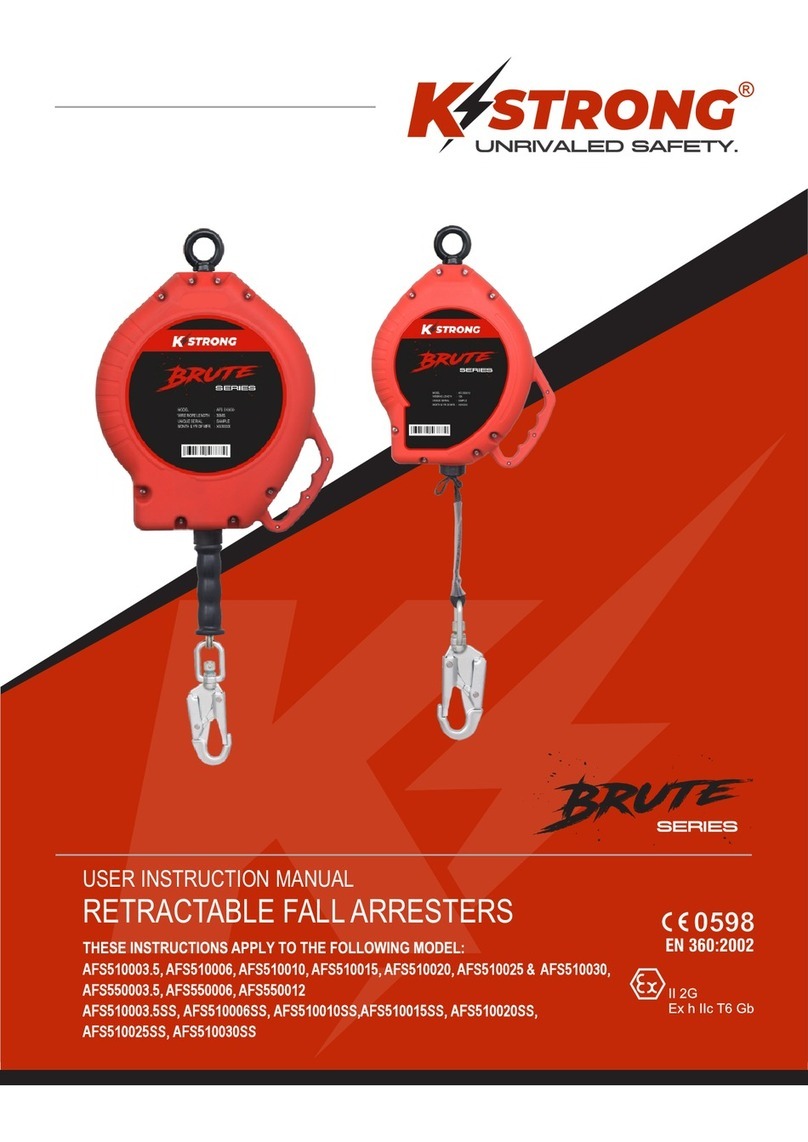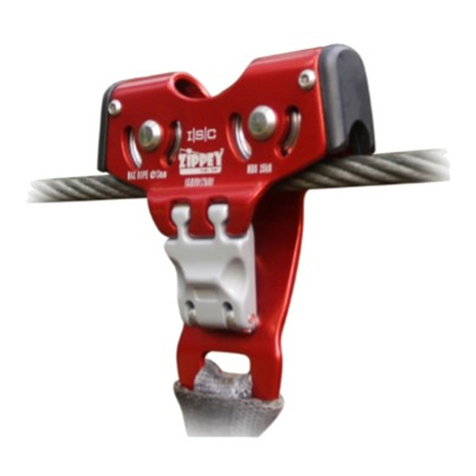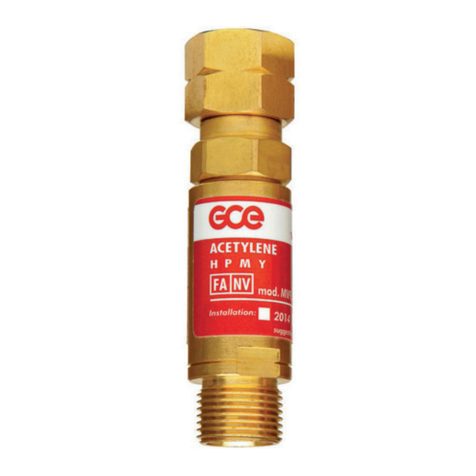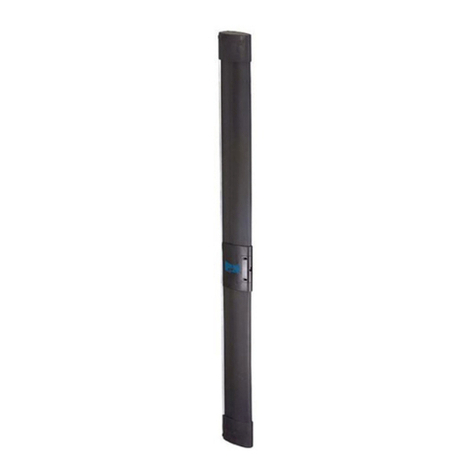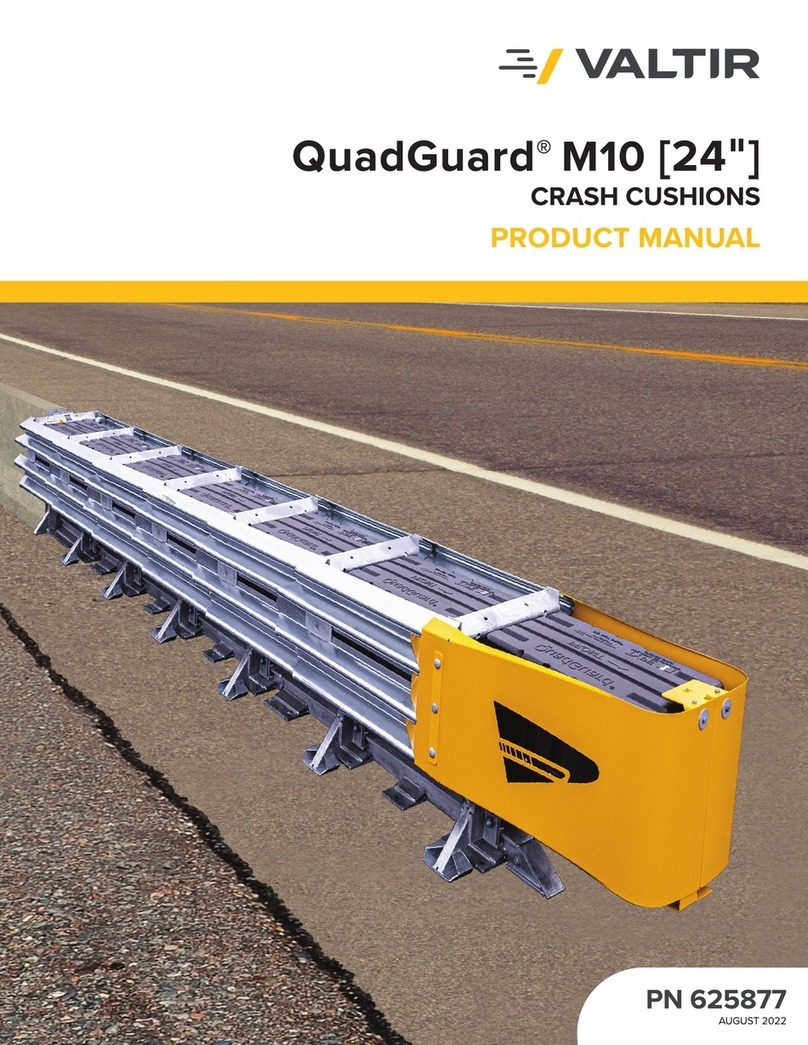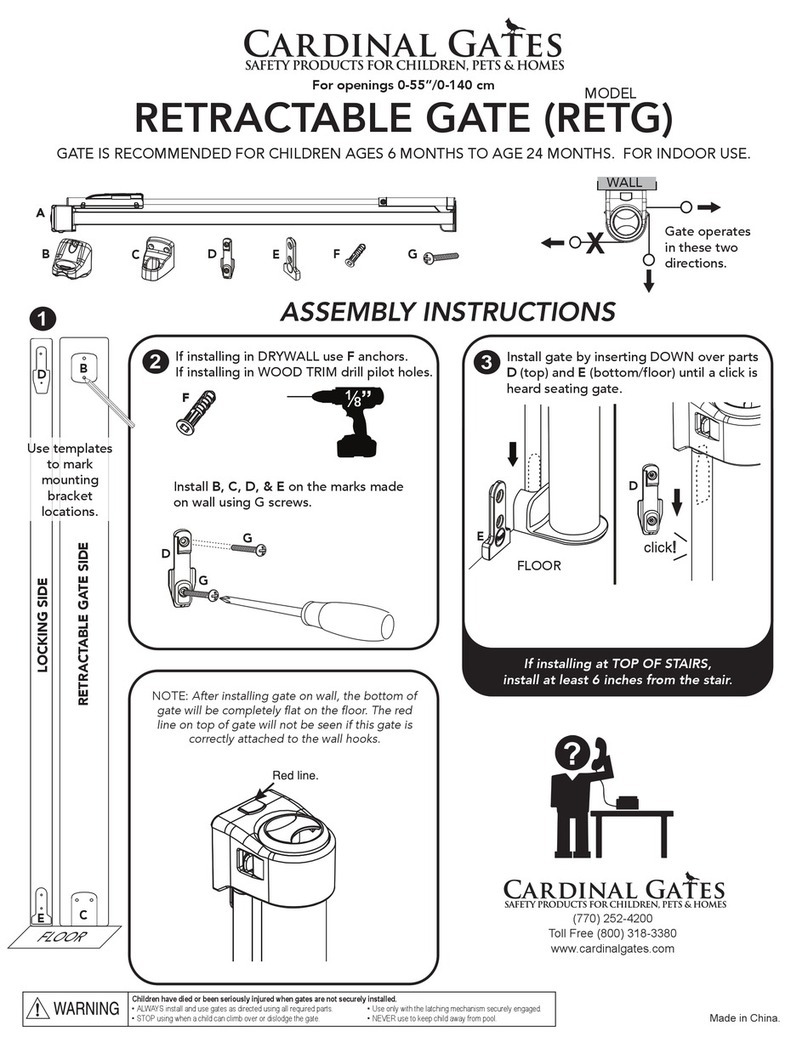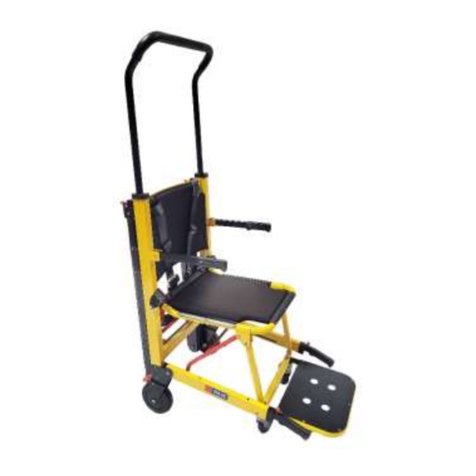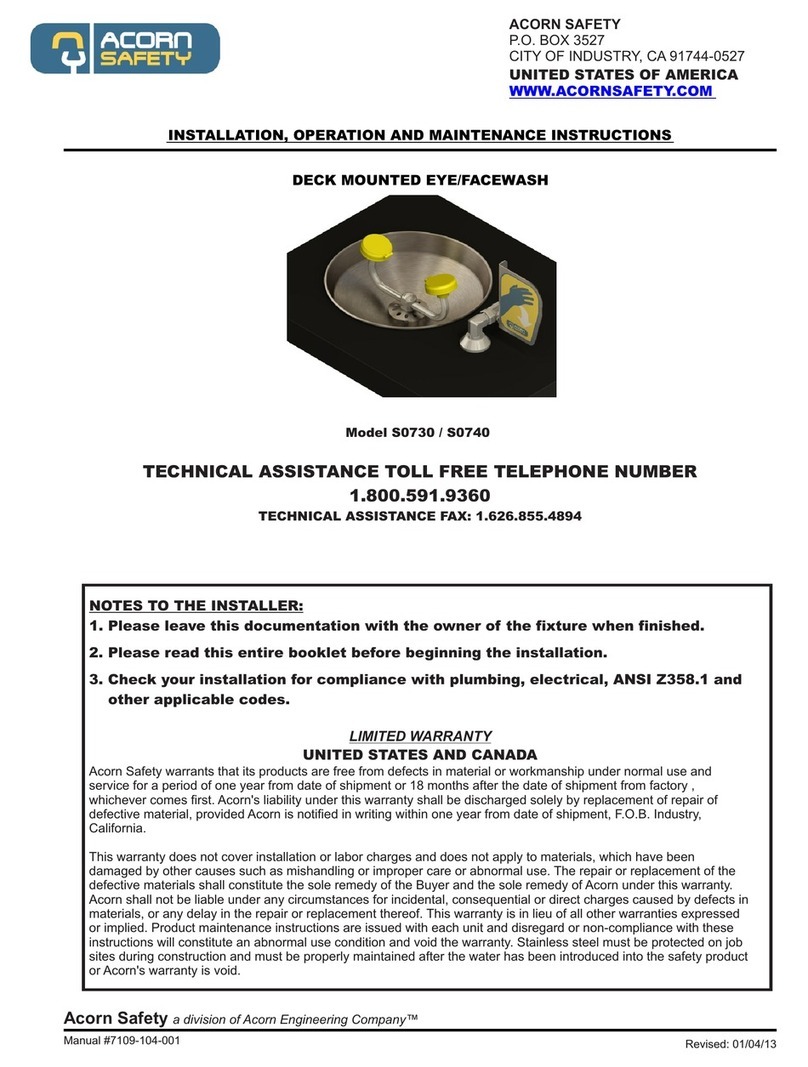Datasensor BWS-T4N Series User manual

1
DATASENSO
R
BWS-T4N SERIES
Barriera di sicurezza pluriraggio di livello 4
1 … 4 coppie di fotocellule
Multiray safety barrier, level 4,
1 … 4 pairs of photocells
MANUALE ISTRUZIONI
INSTRUCTIONS MANUAL

2
WARRANTY
DATASENSOR S.p.A. warrants its products to be free from
defects.
DATASENSOR S.p.A. will repair or replace, free of charge,
any product found to be defective during the warranty period
of 36 months from the manufacturing date.
This warranty does not cover damage or liability deriving
from the improper application of DATASENSOR products.
CONDIZIONI DI GARANZIA
DATASENSOR S.p.A. garantisce i suoi prodotti esenti da
difetti.
DATASENSOR S.p.A. riparerà o sostituirà, gratuitamente,
ogni prodotto che riterrà difettoso durante il periodo di
garanzia di 36 mesi dalla data di fabbricazione.
La garanzia non copre danneggiamenti o responsabilità
dovute ad un uso non corretto del prodotto.
DATASENSOR S.p.A. Via Lavino 265
40050 Monte S. Pietro - Bologna - Italy
Tel: +39 051 6765611 Fax: +39 051 6759324
PRODUCER: TECHNO-GR s.r.l.
DATASENSOR S.p.A. reserves the right to make modifications and improvements without prior notification.
DATASENSOR S.p.A. si riserva il diritto di apportare modifiche e/o miglioramenti senza preavviso.
826000872 Rev.B
D
DE
EC
CL
LA
AR
RA
AT
TI
IO
ON
N
O
OF
F
C
CO
ON
NF
FO
OR
RM
MI
IT
TY
Y
We
DATASENSOR S.p.A.
Via Lavino, 265
40050 Monte San Pietro
Bologna - Italy
declare under our sole responsibility that the product(s)
BWS-T4N AND BWS-T4N-MT SAFETY CONTROLLER (TYPE
4)
to which this declaration relates in conformity with the following
standard(s) or other normative document(s)
CEI EN 55022, JUNE 1997:
LIMITS AND METHODS OF MEASUREMENTS OF RADIO DISTURBANCE OF INFORMATION
TECHNOLOGY EQUIPMENT
CEI EN 61000-4-2, SEPTEMBER 1996:
ELECTROMAGNETIC COMPATIBILITY (EMC). PART 4: TESTING AND MEASUREMENT
TECHNIQUES. SECTION 2: ELECTROSTATIC DISCHARGE IMMUNITY TEST
CEI EN 61000-4-3, NOVEMBER 1997:
ELECTROMAGNETIC COMPATIBILITY (EMC). PART 4: TESTING AND MEASUREMENT
TECHNIQUES. SECTION 3: RADIATED, RADIO-FREQUENCY, ELECTROMAGNETIC FIELD
IMMUNITY TEST
CEI EN 61000-4-4, SEPTEMBER 1996:
ELECTROMAGNETIC COMPATIBILITY (EMC). PART 4: TESTING AND MEASUREMENT
TECHNIQUES. SECTION 4: ELECTRICAL FAST TRANSIENT/BURST IMMUNITY TEST
CEI EN 61000-4-5, JUNE 1997:
ELECTROMAGNETIC COMPATIBILITY (EMC). PART 4: TESTING AND MEASUREMENT
TECHNIQUES. SECTION 5: SURGE IMMUNITY TEST
CEI EN 61000-4-6, NOVEMBER 1997:
ELECTROMAGNETIC COMPATIBILITY (EMC). PART 4: TESTING AND MEASUREMENT
TECHNIQUES. SECTION 6: IMMUNITY TO CONDUCTED DISTURBANCES, INDUCED BY
RADIO-FREQUENCY FIELDS
CEI IEC 61496-2, NOVEMBER 1997:
SAFETY OF MACHINERY - ELECTRO-SENSITIVE PROTECTIVE EQUIPMENT - PART 2:
PARTICULAR REQUIREMENTS FOR EQUIPMENT USING ACTIVE OPTO-ELECTRONIC
PROTECTIVE DEVICES (AOPDS)
Following the provision of the Directive(s):
89/336 CEE AND SUCCESSIVE AMENDMENTS
Monte San Pietro, 02/01/2001
Gianni Stradiotti
Quality Assurance Manager
UNI EN ISO 14001

BWS-T4N Series Instructions manual Serie BWS-T4N Manuale istruzioni
INDEX
1. BEFORE USING THE DEVICE .........................................................1
1.1. GENERAL INSTRUCTIONS..............................................................................1
1.2. ROUTINE MAINTENANCE ...............................................................................1
1.3. AGRO-FOOD INDUSTRIES..............................................................................1
2. GENERAL INFORMATION AND MAIN APPLICATIONS ................2
3. OPERATION ......................................................................................4
4. PRECAUTIONS AND INSTALLATION CRITERIA...........................6
4.1. CALCULATION OF THE MINIMUM INSTALLATION DISTANCE......................6
4.2. REFLECTIVE SURFACES................................................................................6
5. CONNECTIONS.................................................................................7
5.1. REFERENCES ON THE TERMINAL BOARD ...................................................7
5.2. WIRING EXAMPLE...........................................................................................8
5.3. CODES AND DESCRIPTION OF THE AVAILABLE PHOTOCELLS ...............10
6. ALIGNMENT PROCEDURE ............................................................11
7. OPERATING PROCEDURES..........................................................12
7.1. DIP-SWITCHES CONFIGURATION................................................................12
7.2. CONFIGURATION OF THE NUMBER OF PHOTOCELLS..............................12
7.3. MUTING FUNCTION.......................................................................................13
7.3.1. DESCRIPTION ...................................................................................13
7.3.2. INSTALLATION CRITERIA.................................................................13
7.4. OVERRIDE .....................................................................................................18
7.5. STARTING THE OVERRIDE FUNCTION .......................................................18
7.6. TIMING RESTRICTIONS (muting function). ....................................................18
7.7. LED DIAGNOSTIC..........................................................................................19
8. FINAL CHECKS...............................................................................20
9. ROUTINE MAINTENANCE OPERATIONS.....................................20
10. GENERAL INFORMATION AND USEFUL DATA..........................21
11. TECHNICAL DATA..........................................................................22
12. DISPLAY OPERATIVE CODES ......................................................23
12.1. OPERATIVE STATE SIGNALINGS.................................................................23
12.2. FAILURE SIGNALINGS ..................................................................................23
13. OVERALL DIMENSIONS ................................................................25
INDICE
1. PRIMA DELL’UTILIZZO.................................................................... 1
1.1. INDICAZIONI GENERALI................................................................................. 1
1.2. MANUTENZIONE PERIODICA......................................................................... 1
1.3. INDUSTRIE AGRO-ALIMENTARI..................................................................... 1
2. GENERALITÀ E PRINCIPALI APPLICAZIONI ................................ 2
3. FUNZIONAMENTO ........................................................................... 4
4. PRECAUZIONI E CRITERI DI INSTALLAZIONE............................. 6
4.1. CALCOLO DELLA DISTANZA MINIMA DI INSTALLAZIONE ........................... 6
4.2. SUPERFICI RIFLETTENTI............................................................................... 6
5. COLLEGAMENTI .............................................................................. 7
5.1. RIFERIMENTI SULLA MORSETTIERA ............................................................ 7
5.2. ESEMPIO DI CABLAGGIO............................................................................... 8
5.3. CODICI E DESCRIZIONE DELLE FOTOCELLULE DISPONIBILI ...................10
6. PROCEDURA DI ALLINEAMENTO ............................................... 11
7. PROCEDURE OPERATIVE ............................................................ 12
7.1. CONFIGURAZIONE DEI DIP-SWITCH............................................................12
7.2. CONFIGURAZIONE DEL NUMERO DI FOTOCELLULE.................................12
7.3. FUNZIONE DI MUTING...................................................................................13
7.3.1. DESCRIZIONE.......................................................................................13
7.3.2. CRITERI DI INSTALLAZIONE................................................................13
7.4. OVERRIDE......................................................................................................18
7.5. AVVIO DELLA FUNZIONE OVERRIDE...........................................................18
7.6. VINCOLI TEMPORALI (funzione di muting).....................................................18
7.7. DIAGNOSTICA A LED.....................................................................................19
8. CONTROLLI FINALI ....................................................................... 20
9. OPERAZIONI DI MANUTENZIONE PERIODICA........................... 20
10. INFORMAZIONI GENERALI E DATI UTILI.................................... 21
11. DATI TECNICI ................................................................................. 22
12. CODICI OPERATIVI DISPLAY ....................................................... 23
12.1. SEGNALAZIONI DI STATO OPERATIVO. ......................................................23
12.2. SEGNALAZIONI DI GUASTO..........................................................................23
13. DIMENSIONI D’INGOMBRO........................................................... 25

BWS-T4 Series Instructions manual Serie BWS-T4 Manuale istruzioni
1
1
1. BEFORE USING THE DEVICE
1.1. GENERAL INSTRUCTIONS
To guarantee a correct installation, carefully follow the instructions of
this manual.
Do not touch non-insulated cables, unless they have been
disconnected upstream.
Make sure that the cables connected to the control unit are not too
taut and that they do not hinder the movement of persons or things.
The control unit does not contain parts subject to maintenance;
before carrying out any outer operation, turn off the power.
Do not open the container for any reason and in case of failure, send
it to our laboratories by possibly indicating the detected failure and
the operation period.
Avoid touching the protective cover of the lenses with the hands in
order to prevent dust and/or grease from infiltrating the device, thus
reducing the system performances.
The possible wear of the protective covers does not compromise the
system safety in any way but can cause a system locking.
1.2. ROUTINE MAINTENANCE
No special operations are necessary apart from the cleaning of the
optical units.
Do not use woollen clothes.
Do not use solvents.
According to the room conditions, estimate the frequency of this
operation.
DATASENSOR S.p.A. refuses any responsibility for damage to
persons or things due to the incorrect use of the device.
1.3. AGRO-FOOD INDUSTRIES
This device does not require washing and rinsing but simply the lens
cleaning by means of a soft cloth dampened with water; anyway,
apply to the producer to make sure that possible chemical agents
used during the production processes cannot damage the photocells.
1. PRIMA DELL’UTILIZZO
1.1. INDICAZIONI GENERALI
Per una corretta installazione attenersi scrupolosamente alle
istruzioni di questo manuale.
Non toccare cavi non isolati a meno che siano stati sconnessi a
monte.
Assicurarsi che i cavi collegati all’unità di controllo non siano
eccessivamente tesi e che non siano di intralcio al movimento di
persone o cose.
L’unità di controllo non contiene parti soggette a manutenzione,
prima di effettuare qualsiasi intervento esterno togliere
l’alimentazione.
Non aprire il contenitore per alcun motivo, ed in caso di guasto
inviarla ai nostri laboratori possibilmente indicando l’anomalia
riscontrata ed il periodo di funzionamento.
Evitare di toccare la copertura protettiva delle lenti con le mani onde
evitare che polvere e/o grasso riducano le prestazioni.
L’eventuale deterioramento delle coperture protettive non
compromette in alcun modo la sicurezza del sistema ma può
provocare il blocco dello stesso.
1.2. MANUTENZIONE PERIODICA
Non sono richiesti interventi di alcun genere ad esclusione della
pulizia delle parti ottiche.
Non utilizzare panni di lana.
Non utilizzare solventi.
Valutare a seconda delle condizioni degli ambienti la periodicità di
questo intervento.
La DATASENSOR S.p.A. declina ogni responsabilità per danni a
persone o cose dovuti al non coretto utilizzo dell’apparecchiatura.
1.3. INDUSTRIE AGRO-ALIMENTARI
L’apparecchiatura non necessita di lavaggi e sciacquature, ma
semplicemente della pulizia delle lenti con un panno morbido
inumidito con acqua; consultare comunque il costruttore per
verificare che eventuali agenti chimici utilizzati nei processi produttivi
non siano dannosi per le fotocellule.

BWS-T4 Series Instructions manual Serie BWS-T4 Manuale istruzioni
2
2
2. GENERAL INFORMATION AND MAIN APPLICATIONS
The multiray safety barrier of the BWS-T4N series has been produced to
meet the need to protect persons in areas where it is necessary to
guarantee the safety of the operator using machines, robots or in
general automatic systems which are considered dangerous or subject
to casual or undesired access to unsafe parts.
The system conforms with the requirements for safety devices of level 4
in compliance with what described in the latest international standards,
that is to say IEC 61496 1-2.
This safety device is made up of a control unit protected by a plastic
container so that it can be installed on a DIN/OMEGA guide; it has 32
screw terminals to which it is possible to connect from 1 to 4 pairs of
photocells.
This version of the multi-ray safety barrier has the double ‘muting’
function, by means of this function it is possible to connect or disconnect
one or more pair of photocells in order to allow - for instance - the
material passage without stopping the machine. If the device has this
function, an other function must be also possible: The ‘override’ function.
It represents the possibility to force the system, that is to say to close the
output relays even with occupied rays in order to make it possible for the
material which has gathered before the optical devices to proceed.
Both the muting and the override functions represent a system forcing;
for this reason, to activate these functions some precautions limiting the
reduction of the safety level have been added.
The presence of a limb or an object interrupting a beam causes the
opening of the emergency exits and the consequent locking of the duly
connected machine. It is necessary for the barrier to be connected in the
right position in comparison with the passage to be protected in such a
way that there isn’t any possibility to climb over.
Here is a list of the commonly used applications:
à Machines for the processing of wood, glass and ceramic
products.
à Automatic warehouses.
à Conveying lines.
à Palletizers
2. GENERALITÀ E PRINCIPALI APPLICAZIONI
La barriera pluriraggio di sicurezza della serie BWS-T4N è stata
realizzata per coprire le esigenze di protezione di persone in ambienti
nei quali è necessario garantire l'incolumità dell'operatore che utilizzi
macchine, robot o in generale sistemi automatici pericolosi o passibili di
accesso casuale o indesiderato a parti non sicure.
Il sistema risponde ai requisiti per le apparecchiature di sicurezza di
livello 4, in conformità a quanto descritto nelle più recenti norme
internazionali, in particolare la IEC 61496 1-2.
Questo dispositivo di sicurezza è costituito da una centralina in
contenitore plastico per montaggio su guida DIN/OMEGA, dotato di 32
morsetti a vite ai quali è possibile collegare da1 a 4 coppie di fotocellule.
Questa versione della barriera di sicurezza pluriraggio dispone della
funzione di doppio ‘muting’, mediante la quale è possibile includere od
escludere una o più coppie di fotocellule, al fine di consentire, ad
esempio, il passaggio di materiale senza che questo comporti il fermo
della macchina. Quando il dispositivo è dotato di questa funzione,
occorre anche che un’altra funzione sia possibile: la funzione chiamata
‘override’. In pratica rappresenta la possibilità di forzare il sistema, cioé
permette di chiudere i relé di uscita anche a raggi impegnati, per
consentire ad eventuale materiale accumulato davanti alle ottiche, di
poter transitare.
Sia il muting che l’override rappresentano una forzatura del sistema e
quindi per attivare tali funzioni sono previste alcune precauzioni che
limitano il degrado del livello di sicurezza.
La presenza quindi di un arto o di un oggetto che interrompe un fascio
provoca l'apertura delle uscite di sicurezza ed il conseguente blocco
della macchina collegata, che sarà collegata in maniera opportuna ad
essa. È fondamentale che le fotocellule siano collegate nella giusta
posizione rispetto al varco da proteggere in modo che non esistano
possibilità di scavalcamento.
Applicazioni di uso comune sono:
à Macchine di lavorazione legno, vetro, ceramica.
à Magazzini automatici.
à Linee di trasporto.
à Pallettizzatori

BWS-T4 Series Instructions manual Serie BWS-T4 Manuale istruzioni
3
3
The barrier has been planned with reference to the following standards:
IEC 61496-1: 1997. Safety of machinery: electro-sensitive
protective devices
- General requirements and test.
FDIS IEC 61496-2: 1997. Safety of machinery: electro-sensitive
protective devices
- Particular requirements for system
using active opto-electronic devices.
La progettazione della barriera è stata eseguita con riferimento alle
seguenti norme:
IEC 61496-1: 1997. Safety of machinery: electro-sensitive
protective devices
- General requirements and test.
FDIS IEC 61496-2: 1997. Safety of machinery: electro-sensitive
protective devices
- Particular requirements for system
using active opto-electronic devices.

BWS-T4 Series Instructions manual Serie BWS-T4 Manuale istruzioni
4
4
3. OPERATION
The control electronic system is fitted inside the control unit. The ‘core’
of the device is made up of two microprocessors forming - as required
by the standards - a system having “two independent channels”. By
means of the suitable hardware, they continuously control and check the
connected photocells. No interference among the photocells is possible
as they are controlled sequentially; it will be thus possible to install two
or more adjacent photocells. When one or more rays are interrupted, the
electronic system opens the output relays signalling which photocells
have triggered by means of LEDs which can be seen on the container. A
display supplies information on the state and on possible failures.
The control-unit can work in two different modes (please refer to par.7)
which he can carry out the following operations:
• TEST/RESET button: It is used to check if the whole system -
made up of the output relays of the control unit and the machine
actuator - works effectively. By pressing this button (opening the
contact) you practically simulate the interruption of one or more
safety rays and check that the machine stops according to the
established times and modes.
• START/RESTART button: It is used to start the system which has
been just powered - in case you are in a condition of manual reset
- and to start it again when it has locked after a relay triggering (if
you are in a condition of manual reset) or after an error which can
be reset (see table relating to the error codes).
Two types of different operating modes are also available:
1. Automatic restoring, that is to say after the triggering caused by
the detection of an object: The barrier starts to work again
normally when the object is removed.
2. Manual reset by means of the reset button so that the return to
the normal operating mode takes place only after the object has
been removed and the button has been pressed.
During the barrier working, no operation set by means of the user
interface involves functions which can influence the system safety.
These barriers have also a model with muting function on each optical
device. During the operation, this feature makes it possible to connect or
disconnect any available optical device from the protection function by
respecting special times.
3. FUNZIONAMENTO
L’elettronica di controllo è alloggiata all’interno della centralina.
Il cuore del dispositivo è costituito da due microprocessori che
costituiscono, come richiesto dalle normative, un sistema a “due canali
indipendenti”.
Essi provvedono mediante l’apposito hardware, a pilotare e verificare
continuamente le fotocellule collegate. Quando uno o più raggi vengono
interrotti, l’elettronica provvede ad aprire i relè di uscita, segnalando
mediante led visibili sul contenitore quali fotocellule sono intervenute.
Un display provvede a fornire indicazioni sullo stato e su eventuali
anomalie.
L'utente dispone di due pulsanti con i quali può compiere le seguenti
operazioni:
• Pulsante di TEST/RESET: serve a verificare se tutto il sistema
costituito da relè di uscita della centralina più l’attuatore della
macchina è efficiente. Premendo tale pulsante (aprendo il
contatto) in pratica simuliamo l’interruzione di uno o più raggi di
sicurezza e verifichiamo che la macchina si fermi nei tempi e nei
modi definiti.
• Pulsante di START/RESTART: serve ad avviare il sistema
appena alimentato, nel caso ci troviamo in condizioni di ripristino
manuale, ed a riavviarlo quando è in blocco a seguito di un
intervento (se siamo in condizioni di ripristino manuale) o di un
errore ripristinabile (vedi tabella codici di errore).
La centralina può operare in due diverse modalità di funzionamento
(riferirsi al paragrafo 7):
1. Ripristino automatico, cioè dopo l'intervento causato dal
rilevamento di un oggetto, la barriera riprende il normale
funzionamento nel momento in cui l'oggetto viene rimosso.
2. Ripristino manuale, attraverso il pulsante di ripristino per cui il
ritorno alla modalità operativa normale avviene solo dopo che
l'oggetto è stato rimosso e che il pulsante è stato premuto.
Durante il funzionamento della barriera nessuna operazione impostata
attraverso l'interfaccia utente coinvolge funzioni che possano influire
sulla sicurezza del sistema.
Queste barriere dispongono inoltre di un modello con funzione di muting
su ciascuna ottica. Tale caratteristica permette durante il funzionamento,
nel rispetto di particolari tempistiche, di escludere o includere dalla
funzione di protezione una qualsiasi delle ottiche disponibili.

BWS-T4 Series Instructions manual Serie BWS-T4 Manuale istruzioni
5
5
The optical devices which must be set on muting during the operation
can be pre-set by the user by means of a dip-switch (please refer to par.
7.1).
Even the models showing this feature can be both with manual and
automatic restoring.
Le ottiche che durante il funzionamento dovranno essere poste in
muting, possono essere preimpostate dall’utente mediante un dip-switch
(riferirsi paragrafo 7.1).
Anche i modelli che dispongono di questa caratteristica possono essere
sia con ripristino manuale che automatico.

BWS-T4 Series Instructions manual Serie BWS-T4 Manuale istruzioni
6
6
4. PRECAUTIONS AND INSTALLATION CRITERIA
The area on which the barrier must be installed must be compatible
with the technical features of the device; room temperature, troubles
of electromagnetic, luminous or other character must be previously
evaluated possibly applying to the producer for data which are not
reported on this manual.
4.1. CALCULATION OF THE MINIMUM INSTALLATION DISTANCE
The safety distance ‘S’ must be sufficient to guarantee that the
dangerous area cannot be reached by the operator up to the moment
in which the machine with moving part stops. The formula used to
calculate the safety distance for multiray barriers is the following one:
S = ( K * T ) + C
S = safety distance.
T = T1 + T2
whereas T1 = machine response time in seconds.
T2 = barrier response time in seconds.
K = 1600 mm/s (speed of the body approaching the dangerous area).
C = 850 mm (1200 mm for systems with single optical unit).
The height of ray from earth, in case of multirays barrier, are defined in following table:
4 rays 3 rays 2 rays
height of 1º ray 300 mm 300 mm 400 mm
height of 2º ray 600 mm 700 mm 900 mm
height of 3º ray 900 mm 1100 mm --
height of 4º ray 1200 mm -- --
4.2. REFLECTIVE SURFACES
In case reflecting surfaces are present, the distance must be sufficient to
avoid the possibility of passive reflections.
Object
TX barRX bar A
A
2°2°
2°
2°
reflective material
reflective material
4. PRECAUZIONI E CRITERI DI INSTALLAZIONE
L’ambiente in cui deve essere installata la barriera, deve essere
compatibile con le caratteristiche tecniche del dispositivo;
temperatura ambientale, disturbi di natura elettromagnetica e
luminosa e altro, vanno valutati a priori eventualmente consultando il
costruttore per dati non presenti in questo manuale.
4.1. CALCOLO DELLA DISTANZA MINIMA DI INSTALLAZIONE
La distanza di sicurezza ‘S’ deve essere tale da assicurare che la
zona di pericolo non possa essere raggiunta dall’operatore, fino a
che la macchina con l’organo in movimento sia ferma. La formula per
calcolare la distanza di sicurezza per barriere multiraggio è la
seguente:
S = ( K * T ) + C
S = distanza di sicurezza.
T = T1 + T2
dove T1 = tempo di risposta della macchina in secondi.
T2 = tempo di risposta della barriera in secondi.
K = 1600 mm/s (velocità di avvicinamento del corpo alla zona
pericolosa).
C = 850 mm (1200 mm per sistemi con ottica singola).
L'altezza dei raggi da terra nel caso di sbarramenti pluriraggio deve rispettare la
tabella che segue:
4 raggi 3 raggi 2 raggi
altezza del 1º raggio 300 mm 300 mm 400 mm
altezza del 2º raggio 600 mm 700 mm 900 mm
altezza del 3º raggio 900 mm 1100 mm --
altezza del 4º raggio 1200 mm -- --
4.2. SUPERFICI RIFLETTENTI
Nel caso siano presenti superfici riflettenti occorre che la distanza sia
sufficiente da garantire che non esistano riflessioni passive.
Object
TX barRX bar A
A
2°2°
2°
2°
reflective material
reflective material

BWS-T4 Series Instructions manual Serie BWS-T4 Manuale istruzioni
7
7
5. CONNECTIONS
5.1. REFERENCES ON THE TERMINAL BOARD
Here is a table reporting the function and the connection to be carried
out for each number which is present on the label near the terminal
board:
TERMINAL OUTER CONNECTION
1 - 2 Connect to the 24 Vdc power supply, respecting the polarity indicated on the label.
3 - 4 Start/restart button; connect a normally opened button (N.O.).
4 - 5 Test/reset button; connect a normally closed button (N.C.).
6 - 7 Connect the muting signaller.
8 Input of the muting A sensor. Connect to the N.O. contact of the muting sensor (photocell, proximity
switch, other).
9 Input of the muting B sensor. Connect to the N.O. contact of the muting sensor (photocell, proximity
switch, other).
10 Input of the muting C sensor. Connect to the N.O. contact of the muting sensor (photocell, proximity
switch, others)
11 Input of the muting D sensor. Connect to the N.O. contact of the muting sensor (photocell, proximity
switch, others)
12 Terminal not used.
13 - 14 Safety output 1 with N.O. contact.
15 - 16 Safety output 2 with N.O. contact.
17 - 18 Power supply emitters (TX), photocells 1 and 2. Brown wires (pin 1 of connector) to terminal 17, blue
wires (pin 3 of connector) to terminal 18. (in case of photocell S30 with terminal board, connect 17
and 18 respectively with 1 and 2 of the photocell)
19 - 20 Connect the photocells 1 and 2 to the test input of emitters (TX). Black wire (pin 4 of connector) TX 1
on terminal 19, black wire TX 2 on terminal 20. (in case of photocell S30 with terminal board, connect
these terminals with 3 of the photocell)
21 - 22 Power supply emitters (TX), photocells 3 and 4. Brown wires (pin 1 of connector) to 21 terminal, blue
wires (pin 3 of connector) to terminal 22. (in case of photocell S30 with terminal board, connect 21
and 22 respectively with 1 and 2 of the photocell)
23 - 24 Connect photocells 3 and 4 to the test input of emitters (TX). Black wire (pin 4 of connector) TX 3 on
terminal 23, black wire TX 4 on terminal 24. (in case of photocell S30 with terminal board, connect
these terminals with 3 of the photocell)
25 - 26 Power supply receivers (RX), photocells 1 and 2. Brown wires (pin 1 of connector) to terminal 25,
blue wires (pin 3 of connector) to terminal 26. (in case of photocell S30 with terminal board, connect
25 and 26 respectively with 1 and 2 of the photocell)
27 - 28 Connect to the PNP output of the receivers (RX) photocells 1 and 2. Black wire (pin 4 of connector)
RX1 on terminal 27, black wire RX2 on terminal 28 (in case of photocell S30 with terminal board,
connect these terminals with 6 of the photocell)
29 - 30 Power supply receivers (RX), photocells 3 and 4. Brown wires (pin 1 of connector) to terminal 29,
blue wires (pin 3 of connector) to terminal 30. (in case of photocell S30 with terminal board, connect
29 and 30 respectively with 1 and 2 of the photocell)
31 - 32 Connect to the PNP output of the receivers (RX) photocells 3 and 4. Black wire (pin 4 of connector)
RX3 on terminal 31, black wire RX4 on terminal 32 (in case of photocell S30 with terminal board,
connect these terminals with 6 of the photocell).
5. COLLEGAMENTI
5.1. RIFERIMENTI SULLA MORSETTIERA
Viene riportata una tabella nella quale sono indicati per ciascun
numero presente sull’etichetta a fianco della morsettiera, la relativa
funzione ed il collegamento da effettuare:
MORSETTO COLLEGAMENTO ESTERNO
1 - 2 Connettere alla alimentazione 24 Vdc, rispettando la polarità indicata sull’etichetta
3 - 4 Pulsante di start/restart; collegare un pulsante normalmente aperto (N.A.)
4 - 5 Pulsante di test/reset; collegare un pulsante normalmente chiuso (N.C.)
6 - 7 Collegare il segnalatore di muting
8 Ingresso del sensore di muting A. Collegare al contatto N.A. del sensore di muting (fotocellula,
proximity, altro)
9 Ingresso del sensore di muting B. Collegare al contatto N.A. del sensore di muting (fotocellula,
proximity, altro)
10 Ingresso del sensore di muting C. Collegare al contatto N.A. del sensore di muting (fotocellula,
proximity, altro)
11 Ingresso del sensore di muting D. Collegare al contatto N.A. del sensore di muting (fotocellula,
proximity, altro)
12 Morsetto non utilizzato
13 - 14 Uscita di sicurezza 1 con contatto N.A.
15 - 16 Uscita di sicurezza 2 con contatto N.A.
17 - 18 Alimentazione emettitori (TX) fotocellule 1 e 2. Fili marroni (pin 1 del connettore) al morsetto 17, fili
blu (pin 3 del connettore) al morsetto 18 (nel caso di fotocellula S30 con morsettiera collegare 17 e
18 rispettivamente con 1 e 2 della fotocellula)
19 - 20 Collegare all’ingresso di test dei emettitori (TX) fotocellule 1 e 2. Filo nero (pin 4 del connettore) TX1
sul morsetto 19, filo nero TX2 sul morsetto 20 (nel caso di fotocellula S30 con morsettiera collegare
questi morsetti con il 3 della fotocellula)
21 - 22 Alimentazione emettitori (TX) fotocellule 3 e 4. Fili marroni (pin 1 del connettore) al morsetto 21, fili
blu (pin 3 del connettore) al morsetto 22 (nel caso di fotocellula S30 con morsettiera collegare 21 e
22 rispettivamente con 1 e 2 della fotocellula)
23 - 24 Collegare all’ingresso di test dei emettitori (TX) fotocellule 3 e 4. Filo nero (pin 4 del connettore) TX3
sul morsetto 23, filo nero TX4 sul morsetto 24 (nel caso di fotocellula S30 con morsettiera collegare
questi morsetti con il 3 della fotocellula)
25 - 26 Alimentazione ricevitori (RX) fotocellule 1 e 2. Fili marroni (pin 1 del connettore) al morsetto 25, fili blu
(pin 3 del connettore) al morsetto 26 (nel caso di fotocellula S30 con morsettiera collegare 25 e 26
rispettivamente con 1 e 2 della fotocellula)
27 - 28 Collegare all’uscita PNP dei ricevitori (RX) fotocellule 1 e 2. Filo nero (pin 4 del connettore) RX1 sul
morsetto 27, filo nero RX2 sul morsetto 28 (nel caso di fotocellula S30 con morsettiera collegare
questi morsetti con il 6 della fotocellula).
29 - 30 Alimentazione ricevitori (RX) fotocellule 3 e 4. Fili marroni (pin 1 del connettore) al morsetto 29, fili blu
(pin 3 del connettore) al morsetto 30 (nel caso di fotocellula S30 con morsettiera collegare 29 e 30
rispettivamente con 1 e 2 della fotocellula)
31 - 32 Collegare all’uscita PNP dei ricevitori (RX) fotocellule 3 e 4. Filo nero (pin 4 del connettore) RX3 sul
morsetto 31, filo nero RX4 sul morsetto 32 (nel caso di fotocellula S30 con morsettiera collegare
questi morsetti con il 6 della fotocellula).

BWS-T4 Series Instructions manual Serie BWS-T4 Manuale istruzioni
8
8
5.2. WIRING EXAMPLE
Here is a connection example of the control unit BWS-T4N relating to
a mixed configuration in which all the available models of photocells
have been used.
5.2. ESEMPIO DI CABLAGGIO
Di seguito viene riportato un esempio di collegamento dell'unità di
controllo BWS-T4N relativa ad una configurazione mista, nella quale
sono utilizzati tutti i modelli di fotocellule tra quelli disponibili.
1
2
3
4
5
6
+
-
PNP OUT
TEST
MORSETTIERA INTERNA ALLA
FOTOCELLULA TIPO S30
21
34
+
-
PNP OUT
TEST
CONNETTORE M12 MASCHIO
SULLA FOTOCELLULA
marrone
blu
nero
17 18 19 20 21 22 23 24 25 26 27 28 29 30 31 32
1 2 3 4 5 6 7 8 9 10 11 12 13 14 15 16
ALIMENTAZIONE
PRINCIPALE
24 VDC
FUSIBILE
ESTERNO
LAMPADA
ESTERNA
T
E
S
T
N.
C.
S
T
A
R
T
N.
A.
GND
Contatti dei
sensori di
muting
N.A.
BWS-T4N-MT
control unit
Contatto 2 di
sicurezza
Contatto 1 di
sicurezza
N.C.
S10 TYPE
Emettitore
S5 TYPE
Ricevitore
S10 TYPE
Ricevitore
S5 TYPE
Emettitore
S30 TYPE
Ricevitore
S30 TYPE
Emettitore
+
-test
+
-pnp out
marrone
blu
nero
nero
marrone
blu
nero
nero
Muting
A
-B
Muting
C-D
17 18 19 20 21 22 23 24 25 26 27 28 29 30 31 32
1 2 3 4 5 6 7 8 9 10 11 12 13 14 15 16
MAIN SUPPLY
24 VDC
EXTERNAL
FUSE
EXTERNAL
LAMP
T
E
S
T
N.
C.
S
T
A
R
T
N.
A.
GND
Muting
sensor
contatcs
N.O.
BWS-T4N
control unit
Safety output 2
Safety output 1
N.C.
S10 TYPE
Emitter
S5 TYPE
Receiver
S10 TYPE
Receiver
S5 TYPE
Emitter
S30 TYPE
Receiver
S30 TYPE
Emitter
+
-test
+
-pnp out
brown
bleu
black
black
brown
bleu
black
black
Muting
A
-B
Muting
C-D
1
2
3
4
5
6
+
-
PNP OUT
TEST
TERMINAL BOARD INSIDE TO
S30 TYPE PHOTOCELL
21
34
+
-
PNP OUT
TEST
M12 MALE CONNECTOR
MOUNTED ON PHOTOCELL
brown
bleu
black

BWS-T4 Series Instructions manual Serie BWS-T4 Manuale istruzioni
9
9
Please, note especially what follows:
• Three out of four photocells have been connected choosing
among the ones which can be used; model S5-5 has been
connected to the terminals reòating to TX1-RX1, model S10-5 to
the ones of TX2-RX2, the terminals of TX3-RX3 have not been
used and TX4-RX4 has been connected to model S30-5.
To configure the control unit in such a way that it works only with
three present photocells, it has been necessary to connect the
unused emitter output to the input of the corresponding receiver,
in this case to terminal TEST-TX3 with PNP_OUT-RX3.
All models can be connected in all the possible combinations for
a maximum of four pairs of sensors with at least one pair
connected.
• The transformer which is necessary to power the system must
conform to standard EN 60742 (double insulation) or with equal
insulation, for instance VDE 0551.
• It is necessary to protect the control unit with an outer fuse
having a nominal interruption current equal to 1 A.
• The TEST and START pushbuttons must be positioned in such a
way that the operator can see the protected area when he
restarts, or carries out a test or override operation.
• The outer light device for active muting signalling must be
positioned in a place where it can be seen from any operative
point.
• Read the paragraph relating to the muting function and its use
for the positioning of the activation sensors of this function.
• Both safety contacts OUT1 and OUT2 must be connected. If the
machine has a single locking circuit, the two normally opened
contacts must be connected in series.
• Photocells of the type S5-5 and S10-5 are delivered with wired
cable or standard M12 connector and the wiring on the control
unit is indicated according to the cable colour, or to the male
connector pin number.
• Photocells of the type S30-5 are available also in the version
with terminal board; in this case, it is necessary to carry out the
connections by respecting the same symbols present both on
the terminal board of the control until and on the photocell one.
In particolare si noti quanto segue:
• Sono state collegate tre fotocellule su quattro tra quelle che
possono essere utilizzate; il modello S5-5 è stato collegato ai
morsetti relativi alla coppia TX1-RX1, il modello S10-5 a quelli
della coppia TX2-RX2, i morsetti della coppia TX3-RX3 non sono
stati utilizzati, e la coppia TX4-RX4 è stata collegata con il
modello S30-5.
Si può notare che per configurare l'unità di controllo ad operare
solamente con tre fotocellule presenti, è stato necessario
connettere l'uscita del trasmettitore non utilizzato con l'ingresso
del corrispondente ricevitore, in questo caso il morsetto TEST-
TX3 con PNP_OUT-RX3.
Tutti i modelli possono essere collegati in tutte le combinazioni
possibili per un massimo di quattro coppie di sensori, con almeno
una coppia collegata.
• ll trasformatore necessario ad alimentare il sistema deve essere
conforme alla norma EN 60742 (doppio isolamento), oppure con
isolamento equivalente, es. VDE 0551.
• È necessario proteggere l'unità di controllo con un fusibile
esterno, che abbia una corrente di interruzione nominale di 1 A.
• I pulsanti di TEST e di START devono essere posizionati in
modo che l'operatore possa visionare la zona protetta quando
effettua l'operazione di riavvio, di test o di override.
• Il dispositivo luminoso esterno di segnalazione di muting attivo
deve essere posizionato in un luogo che sia visibile da tutti i lati
operativi.
• Leggere il paragrafo relativo alla funzione di muting ed al suo
utilizzo per il posizionamento dei sensori di attivazione di tale
funzione.
• Entrambi i contatti di sicurezza OUT1 e OUT2 devono essere
collegati. Se la macchina prevede un solo circuito di blocco si
devono collegare in serie i due contatti N.A.
• Le fotocellule del tipo S5-5 e S10-5 sono fornite con il cavo
cablato o con connettore M12 standard, ed il cablaggio sull'unità
di controllo è indicato in relazione al colore del cavo od alla
numerazione del connettore maschio.
• Le fotocellule del tipo S30-5 sono disponibili anche con versione
a morsettiera; in questo caso occorre effettuare i collegamenti
rispettando la stessa simbologia presente sia sulla morsettiera
dell'unità di controllo che in quella della fotocellula.

BWS-T4 Series Instructions manual Serie BWS-T4 Manuale istruzioni
10 10
• The connection cables of the photocells, of muting request, start
and test must be masked with minimum section 22AWG.
The screen braids must be all earthed towards the control unit
side.
In the following paragraph you can find the codes of the available
models which can be used in the wished configuration.
5.3. CODES AND DESCRIPTION OF THE AVAILABLE
PHOTOCELLS
MODEL S5-5
CODE TYPE CONTAINER
S5-5-G8-60-ST4 sender plastic, with 5m of cable
S5-5-G8-62-ST4 sender plastic, with connector M12
S5-5-F8-90-ST4 receiver plastic, with 5m of cable
S5-5-F8-92-ST4 receiver plastic, with connector M12
MODEL S10-5
CODE TYPE CONTAINER
S10-5-G8-60-ST4 sender metal, with 5m of cable
S10-5-G8-62-ST4 sender metal, with connector M12
S10-5-F8-90-ST4 receiver metal, with 5m of cable
S10-5-F8-92-ST4 receiver metal, with connector M12
MODEL S30-5
CODE TYPE CONTAINER
S30-5-G50-1ST4 sender plastic, connection to terminal board
S30-5-G50-2ST4 sender plastic, with connector M12
S30-5-F50-1ST4 receiver plastic, connection to terminal board
S30-5-F50-2PST4 receiver plastic, with connector M12
• I cavi di collegamento delle fotocellule, di richiesta di muting, di
start e test devono essere schermati, con sezione minima
22AWG. Le calze dello schermo devono essere collegate tutte a
terra verso il lato centralina.
Nel paragrafo successivo sono riportati i codici dei modelli disponibili
ad essere utilizzati nella configurazione desiderata.
5.3. CODICI E DESCRIZIONE DELLE FOTOCELLULE DISPONIBILI
MODELLO S5-5
CODICE TIPO CONTENITORE
S5-5-G8-60-ST4 emettitore plastico, con 5m di cavo
S5-5-G8-62-ST4 emettitore plastico, con connettore M12
S5-5-F8-90-ST4 ricevitore plastico, con 5m di cavo
S5-5-F8-92-ST4 ricevitore plastico, con connettore M12
MODELLO S10-5
CODICE TIPO CONTENITORE
S10-5-G8-60-ST4 emettitore metallico, con 5m di cavo
S10-5-G8-62-ST4 emettitore metallico, con connettore M12
S10-5-F8-90-ST4 ricevitore metallico, con 5m di cavo
S10-5-F8-92-ST4 ricevitore metallico, con connettore M12
MODELLO S30-5
CODICE TIPO CONTENITORE
S30-5-G50-1ST4 emettitore plastico, connessione a morsettiera
S30-5-G50-2ST4 emettitore plastico, con connettore M12
S30-5-F50-1ST4 ricevitore plastico, connessione a morsettiera
S30-5-F50-2PST4 ricevitore plastico, con connettore M12

BWS-T4 Series Instructions manual Serie BWS-T4 Manuale istruzioni
11 11
6. ALIGNMENT PROCEDURE
After having carried out the correct mechanical assembly and the
correct connections as described in the previous paragraphs, it is
necessary to align the pairs of photocells. Follow the operative
modes as follows:
• Turn off the power supplying the control unit.
• Open the test contact.
• Power the control unit.
• Align the photocells by observing the LEDs on the control unit:
If the alignment of the relevant pair of photocell is correct, the
LED is turned on.
• After the alignment, turn off the power supplying the control
unit, close the test contact and power the control unit again.
• Wait for the control unit to carry out the initial tests, visualizing
on the display a count-down which indicates the control unit
activity.
• At the end of this operation, the display will visualize letter ‘A’
indicating the active state of the control unit.
• Carry out all the checks described in the final checks and in
the routine maintenance operations.
During aligning operations or normal working, check that the photocells
connected to the same or other units do not interfere which each other,
modifying their mutual position, for instance by positioning some pairs of
emitters on the other receiver side.
6. PROCEDURA DI ALLINEAMENTO
Dopo avere effettuato il corretto montaggio meccanico ed i corretti
collegamenti come descritto nei paragrafi precedenti occorre
allineare le copie di fotocellule. Seguire le modalità operative di
seguito descritte:
• Togliere l’alimentazione all’unità di controllo.
• Aprire il contatto di test.
• Alimentare l’unità di controllo.
• Allineare le fotocellule guardando i led posti sulla centralina: a
led acceso corrisponde un corretto allineamento della relativa
coppia di fotocellule.
• Ad allineamento concluso, togliere l’alimentazione alla
centralina, chiudere il contatto di test e rialimentare la
centralina.
• Attendere che la centralina esegua i test iniziali, visualizzando
sul display un count-down che indica l’attività della centralina.
• Al termine di tale operazione il display visualizzerà la lettera ‘A’
che indica lo stato attivo della centralina.
• Procedere a tutte le verifiche descritte nei controlli finali e nelle
operazioni di manutenzione periodica.
Durante le operazioni di allineamento o durante il normale
funzionamento verificare che le fotocellule collegate alla stessa o ad
altre unità non interferiscano tra loro, modificando la posizione
reciproca, ad esempio posizionando alcune coppie di emettitori dal lato
degli altri ricevitori.

BWS-T4 Series Instructions manual Serie BWS-T4 Manuale istruzioni
12 12
7. OPERATING PROCEDURES
7.1. DIP-SWITCHES CONFIGURATION
The configuration indicated in table must be selected on both the dip-
switch present on the side of the control unit, after to have removed the
cap of protection. The description corresponding to the pre-choosen
selection is reported.
1 function
X not used
2 function
Off muting A-B act on the sensor couples 1
and 2.
muting C-D act on the sensor couples 3
and 4.
On muting A-B act on the sensor couple 1.
muting C-D act on the sensor couple 2.
The sensor couples 3-4 continue to
function normally.
3 function
4 function
Off muting 60 s Off manual restoring
On muting ∞s On automatic restoring
The control-unit is manufactured from the factory with the following
configuration:
• Automatic restoring, all four optics in muting, the maximum
duration of the muting is of sixteen seconds.
7.2. CONFIGURATION OF THE NUMBER OF PHOTOCELLS
In case you use a number of photocells which is lower than 4, operate
as follows: to disconnect the photocells do not use and therefore do not
connect to the control unit; carry out a connection among the following
terminals:
unused photocell connection
1 19 to 27
2 20 to 28
3 23 to 31
4 24 to 32
At least one pair of photocells must be connected, otherwise (condition
of all the disconnected photocells) the control unit is locked.
7. PROCEDURE OPERATIVE
7.1. CONFIGURAZIONE DEI DIP-SWITCH.
La configurazione indicata in tabella deve essere selezionata su
entrambi i dip-switch presenti sul fianco della centralina, dopo aver
asportato il tappo di protezione: si riporta la descrizione
corrispondente alla selezione prescelta:
1 funzione
X non utilizzato
2 funzione
Off muting A-B agiscono sulle coppie di
sensori 1 e 2
muting C-D agiscono sulle coppie di
sensori 3 e 4
On muting A-B agiscono sulla coppia di
sensori 1
muting C-D agiscono sulla coppia di
sensori 2
le coppie di sensori 3-4 continuano
ad operare normalmente
3 funzione
4funzione
Off muting 60 s Off ripristino manuale
On muting ∞s On ripristino automatico
La centralina esce dalla fabbrica configurata nel seguente modo:
• Ripristino automatico, tutte 4 le ottiche in muting, durata
massima del muting di 60 secondi.
7.2. CONFIGURAZIONE DEL NUMERO DI FOTOCELLULE
In caso di utilizzo di un numero di fotocellule inferiore a 4 agire come
segue:
per escludere le fotocellule non utilizzate e quindi non collegate
all’unità di controllo fare un collegamento tra i seguenti morsetti:
fotocellula non utilizzata collegamento
1 19 con 27
2 20 con 28
3 23 con 31
4 24 con 32
NOTE: configure the two dip-
switch in the same waj,otherwise
the central control unit is locked
and code '8' is displayed.
1
2
3
4
ON
1
2
3
4
ON
SW2SW1
NOTA BENE: configurare i due
dip-switch nello stesso modo, in
caso contrario la centralina andrà
in blocco visualizzando il codice '8'
sul display.
1
2
3
4
ON
1
2
3
4
ON
SW2
SW1

BWS-T4 Series Instructions manual Serie BWS-T4 Manuale istruzioni
13 13
Almeno una coppia di fotocellule deve essere collegata, in caso
contrario (condizione con tutte le fotocellule escluse) la centralina si
blocca.

BWS-T4 Series Instructions manual Serie BWS-T4 Manuale istruzioni
14 14
7.3. MUTING FUNCTION.
7.3.1. DESCRIPTION.
The muting function makes it possible to connect or disconnect
one or more optical devices during the operation according to the
operative needs. As required by the standard, the control unit has
two inputs for the activation of this function. Two separate muting
functions are present.
It is necessary to duly connect the muting sensors in order to avoid
that a wrong positioning can cause undesired muting requests. It is
nevertheless necessary to remember that the muting function
represents a system forcing and for this reason it must be used
with care.
By means of the inner DIP-SWITCHES, it is possible to decide
which optical units must be set on muting (that is to say, which
optical units must be disconnected) after a request (see DIP-
SWITCHES setting).
To use the muting function, it is necessary also to connect the
muting signaller without which the control unit locks.
7.3.2. INSTALLATION CRITERIA
1. The muting sensors must recognise the material (namely pallets,
vehicles, etc.) in all its length.
2. The sensors must be arranged in such a way that the material is
recognised even when it must be lifted for the relevant processing.
3. In case of different transport speeds in the muting area, always
bear in mind their influence on the muting total duration.
4. All the safety photocells and the muting sensors must be arranged
in such a way that the previous material has already passed the
last muting sensor before the new material has reached the first
sensors.
7.3. FUNZIONE DI MUTING
7.3.1. DESCRIZIONE
La funzione di muting consente di escludere o includere una o più
ottiche durante il funzionamento, in relazione alle esigenze
operative. La centralina è dotata, come richiesto dalla normativa,
di due ingressi per l’attivazione di ogni funzione di muting; due
separate funzioni di muting sono presenti.
E’ necessario collegare opportunamente i sensori di muting onde
evitare che un cattivo posizionamento, possa essere causa di
richieste di muting indesiderate. Occorre comunque ricordare che
la funzione di muting rappresenta pur sempre una forzatura del
sistema, e che quindi va utilizzata con le dovute cautele.
E’ possibile mediante i DIP-SWITCHES, decidere quali ottiche
dovranno andare in muting (essere escluse) a seguito di una
richiesta. (vedere impostazione dei DIP-SWITCHES).
Per utilizzare la funzione di muting è necessario collegare anche il
segnalatore esterno di muting senza il quale la centralina si
blocca.
7.3.2. CRITERI DI INSTALLAZIONE
1. I sensori del muting devono riconoscere il materiale (i.e. pallet,
veicoli, ..) in tutta la sua lunghezza.
2. I sensori devono essere disposti in modo che il materiale venga
riconosciuto anche quando debba essere sollevato per la
lavorazione.
3. Nel caso di diverse velocità di trasporto nel campo del muting
tenere in considerazione il loro effetto sulla durata totale del
muting.
4. Tutte le fotocellule di sicurezza ed i sensori di muting devono
essere disposti in modo che il materiale precedente abbia già
passato l’ultimo sensore di muting prima che il nuovo materiale
abbia raggiunto i primi sensori.
S1
S2
S3
B2 A2 B1 A1
S1
S2
S3
B2 A2 B1 A1

BWS-T4 Series Instructions manual Serie BWS-T4 Manuale istruzioni
15 15
In the previous page, an installation example of a protection arranged
on a conveyor is drawn; it must allow the passage of package 1,
preventing other packages from passing or it must allow the passage
of packages 1 and 2, preventing package 3 from passing. The
protection photocells Sare connected to the BWS-T4N control unit
and are temporaneously cut-out at the package passage by means of
the muting A1, A2, B1 and B2 activation sensors.
Sensors Aand Bare optical, mechanical, proximity, etc. sesnors with
closed contact in the presence of the object to be detected.
In both cases, the configuration dip-switch 2 must be set in the on
position.
Application with four muting sensors, passage permitted only for package 1:
N
.C.
A
1B1
S
A
2B2
d1
Muting sensor connection:
contact of A1
contact of A2
contact of B1
contact of B2
24 VDC
BWS-T4N
terminals
D
L
v
9MUTE A
8MUTE B
11 MUTE C
10 MUTE D
N
.C.
Application with four muting sensors, passage permitted only for packages 1 and 2:
A
1B1
S
A
2B2
d1
Muting sensor connection:
contact of A1
contact of A2
contact of B1
contact of B2
24 VDC
BWS-T4-MT
terminals
9MUTE A
8MUTE B
D
L
v
11 MUTE C
10 MUTE D
Nella pagina precedente è disegnato un esempio di installazione di una
protezione disposta su un trasportatore che deve consentire il passaggio del
pacco 1 impedendo il passaggio degli altri, oppure deve permettere il passaggio
del pacco 1 e 2 impedendo il passaggio del pacco 3. Le fotocellule di protezione
Svengono collegate all'unità di controllo BWS-T4N e vengono
temporaneamente escluse al passaggio del pacco per mezzo dei sensori di
attivazione del muting A1, A2, B1 e B2.
I sensori Ae Bsono sensori ottici, meccanici, di prossimità, etc., con contatto
chiuso in presenza dell'oggetto da rilevare.
In entrambi i casi in esame il dip-switch 2 di configurazione deve essere posto
nella posizione on.
Applicazione con quattro sensori di muting, caso di passaggio permesso solo al pacco
1:
N
.C.
A
1B1
S
A
2B2
d1
Collegamento dei sensori di muting:
contatto di A1
contatto di A2
contatto di B1
contatto di B2
24 VDC
morsettiera
BWS-T4N
D
L
v
9MUTE A
8MUTE B
11 MUTE C
10 MUTE D
N
.C.
Applicazione con quattro sensori di muting, caso di passaggio permesso al pacco 1 e 2:
A
1B1
S
A
2B2
d1
Collegamento dei sensori di muting:
contatto di A1
contatto di A2
contatto di B1
contatto di B2
24 VDC
morsettiera
BWS-T4N
9MUTE A
8MUTE B
D
L
v
11 MUTE C
10 MUTE D

BWS-T4 Series Instructions manual Serie BWS-T4 Manuale istruzioni
16 16
Application with two muting sensors, passage permitted only for package 1:
A
S
B
d1 = D
Muting sensor connection:
contact of A
contact of B
24 VDC
BWS-T4N
terminals
9MUTE A
8MUTE B
11 MUTE C
10 MUTE D
N
.C.
N
.C.
D: minimum distance sdo that the muting sensors keep
active the request; it depends on the parcel length: D <
L.
d1: necessary maximum distance so that the muting
request is accepted; it depends on the parcel speed:
d
max [cm]= v[m/s] * 3[s] * 100
This distance must not allow to activate both sensors
and the muting with the accidental passage of a
person.
Application with four muting sensors and only photocell S1:
Power cable
Li
g
ht cable
Mutin
g
cable
RX cable
TX cable
Muting
signalizer
Start & Test
button
Protect the
cables
BWS-T4
control-unit
Applicazione con due sensori di muting e caso di passaggio permesso solo al pacco 1:
A
S
B
d1 = D
Collegamento dei sensori di muting:
contatto di A
contatto di B
24 VDC
morsettiera
BWS-T4N
9MUTE A
8MUTE B
11 MUTE C
10 MUTE D
N
.C.
N
.C.
D: distanza minima affinché i sensori di muting
mantengano attiva la richiesta; è funzione della
lunghezza del pacco: D < L.
d1: distanza massima necessaria affinché la richiesta di
muting venga accettata; è funzione della velocità del
pacco:
d
max [cm]= v[m/s] * 3[s] * 100
Applicazione con quattro sensori di muting e solo la fotocellula S1:
Power cable
Li
g
ht cable
Mutin
g
cable
RX cable
TX cable
Muting
signalizer
Start & Test
button
Protect the
cables
BWS-T4
control-unit

BWS-T4 Series Instructions manual Serie BWS-T4 Manuale istruzioni
17 17
N
.C.
A
1B1
S
A
2B2
d1
Muting sensor connection:
contact of A1
contact of A2
contact of B1
contact of B2
24 VDC
BWS-T4N
terminals
D
L
v
9MUTE A
8MUTE B
11 MUTE C
10 MUTE D
N
.C.
The examples above are thought for the use of the muting functions only
relating to sensors S1 and S2, with the configuration DIP-SWITCH 2 in
the off positions; sensors S1 and S2 are controlled by the muting A and
B inputs, while sensors S3 and S4 are controlled by the muting C and D
inputs. His configuration makes other applications be possible.
Application with eight muting sensors and output and input control
We imagine an area in which a manipulator acts; the barriers in input
and output must allow the poassage of the packages only when the
manipulator has terminated its work, thus avoiding intrusions in
unwished moments.
S3
S4
B4 A4 B3 A3
S
1
S2
A2 B1 A1
Manipulator
activity
B2
N
.C.
A
1B1
S
A
2B2
d1
Collegamento dei sensori di muting:
contatto di A1
contatto di A2
contatto di B1
contatto di B2
24 VDC
morsettiera
BWS-T4N
D
L
v
9MUTE A
8MUTE B
11 MUTE C
10 MUTE D
N
.C.
Gli esempi riportati sono indirizzati all'utilizzo delle funzioni di muting
relativamente ai soli sensori S1 e S2, ponendo il DIP-SWITCH di
configurazione 2 sulla posizione off, i sensori S1 e S2 vengono
controllati dagli ingressi di muting A e B, mentre i sensori S3 e S4
vengono controllati dagli ingressi di muting C e D, tale configurazione
permette altre applicazioni.
Applicazione con otto sensori di muting e controllo d'ingresso e uscita:
Si suppone un'area nella quale agisce un manipolatore, le barriere in
ingresso ed uscita devono permettere il passaggio dei pacchi solo se il
manipolatore ha terminato il proprio lavoro, in modo da evitare intrusioni in
momenti non desiderati.
S3
S4
B4 A4 B3 A3
S1
S2
A2 B1 A1
Zona d'intervento
del manipolatore
B2
Table of contents
Other Datasensor Safety Equipment manuals
Popular Safety Equipment manuals by other brands

Tractel
Tractel travsafe PA Installation, operating and maintenance manual

Crewsaver
Crewsaver MIRG ELITE TWIN CHAMBER LIFEJACKET Service manual
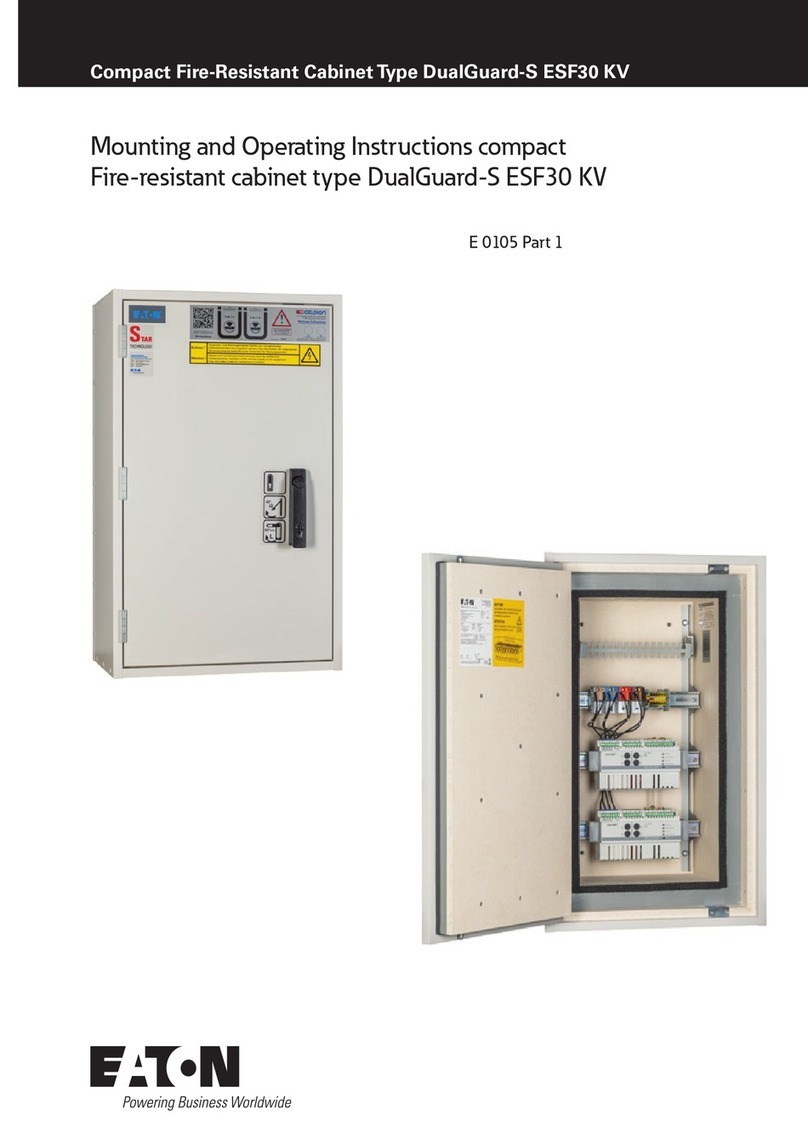
Eaton
Eaton DualGuard-S ESF30 KV Mounting and operating instructions
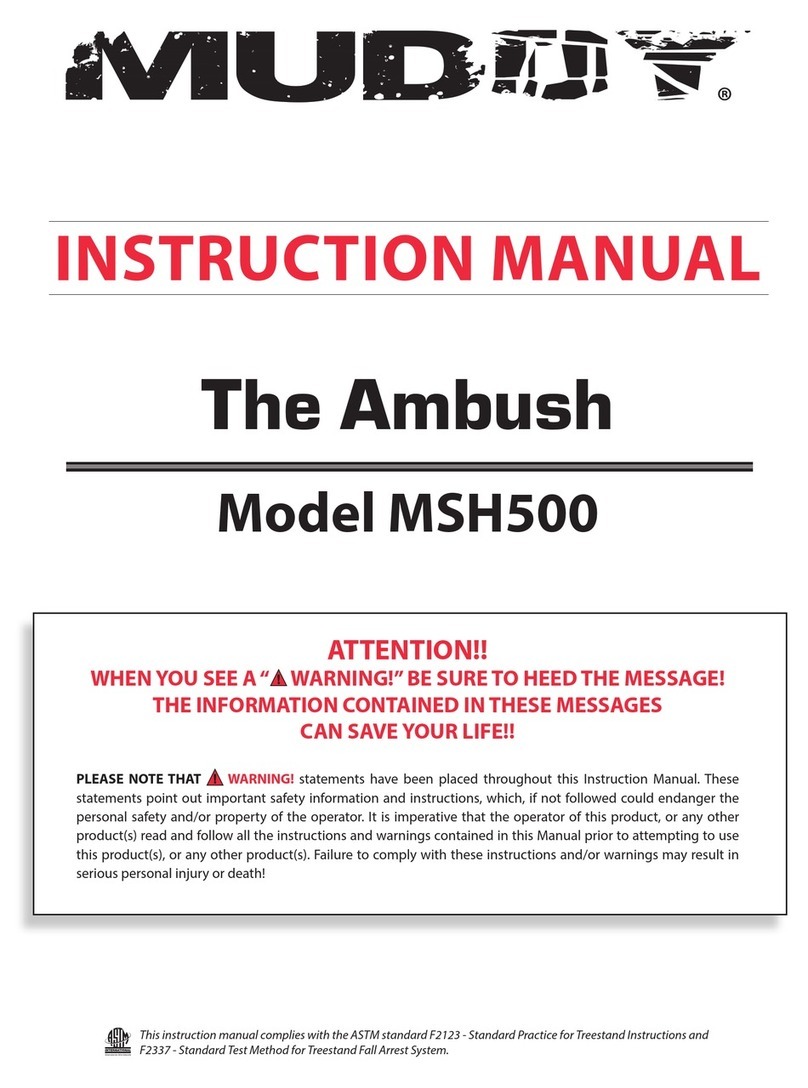
Muddy
Muddy Ambush MSH500 instruction manual
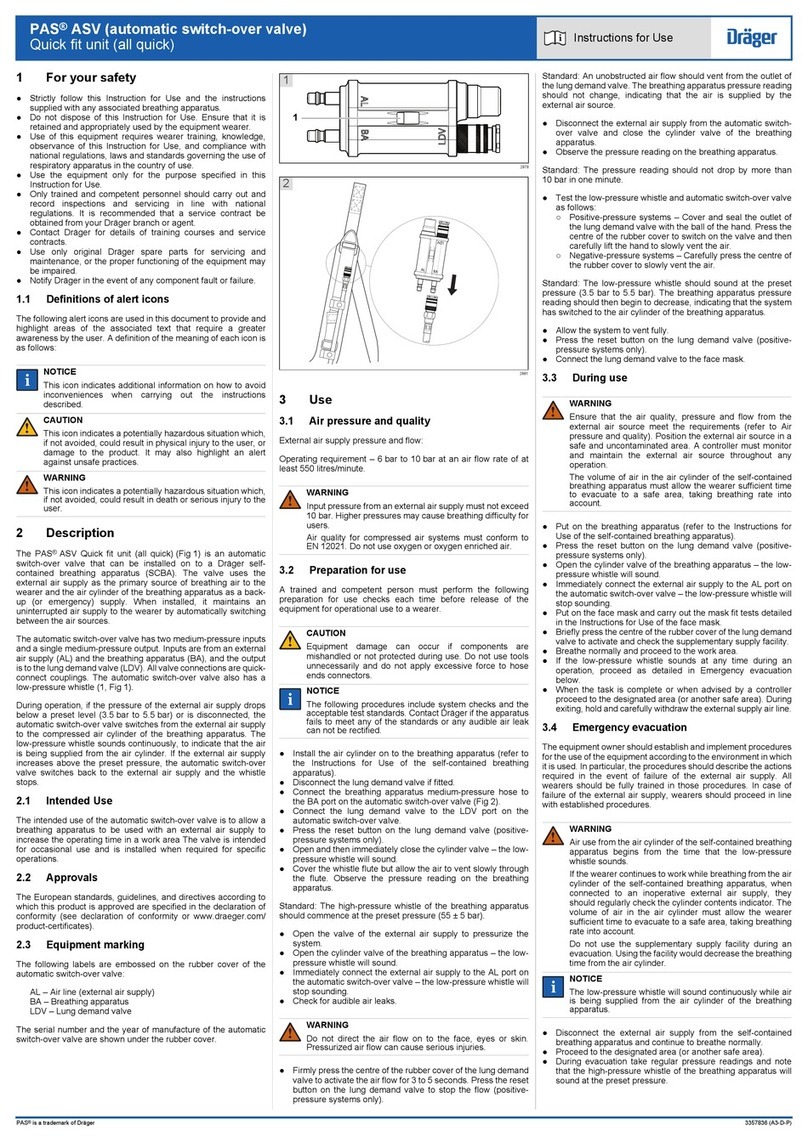
Dräger
Dräger PAS ASV Instructions for use

Safehold
Safehold Roundslings Instructions for safe use
